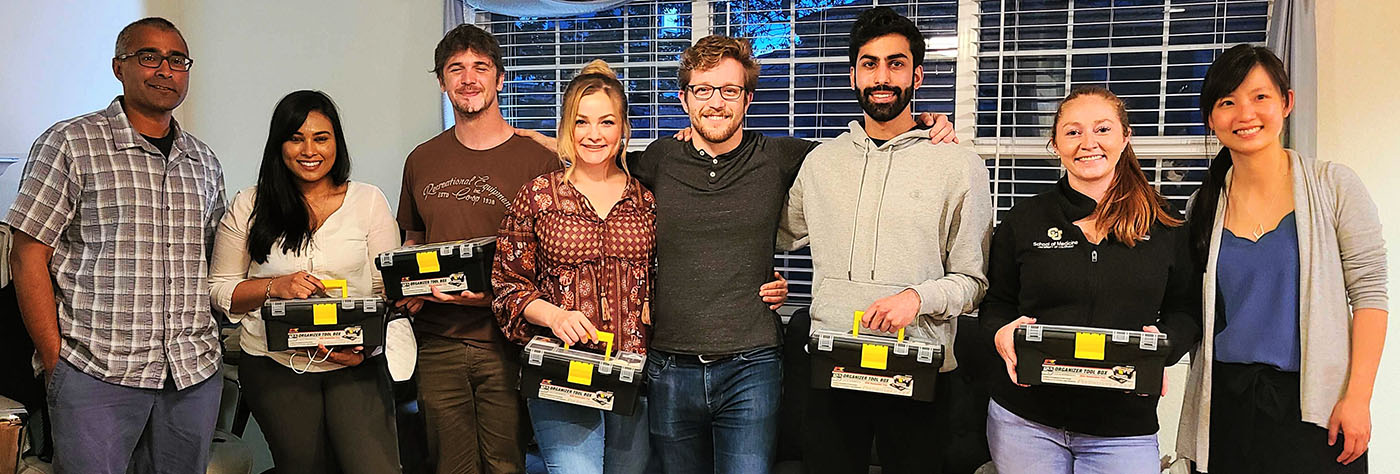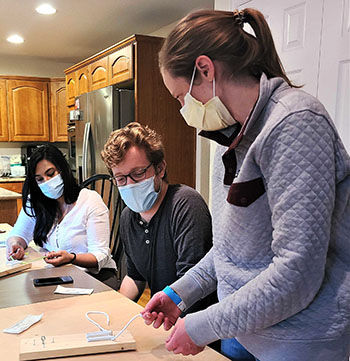
Members of the CU chapter of the Global Surgery Student Alliance gathered in May to practice skills using the GlobalSurgBox.
Creating a Surgical Training Tool
GlobalSurgBox meets local and global needs
By Valerie Gleaton
(October 2021) Last May, more than 20 medical students from the University of Colorado School of Medicine, along with several residents, fellows, and faculty members from the Department of Surgery, gathered in the home of Yihan Lin, MD, MPH, a cardiothoracic surgery fellow.
The group watched a video tutorial about how to tie square knots, then broke into smaller teams to practice the skill, looping shoelaces around nails hammered into wooden boards. The activity was reminiscent of an arts and crafts night, but these were no friendship bracelets or macramé wall hangings. Instead, the students were learning essential surgical skills to better prepare them for the operating room and the wards.
Practice makes perfect
The event was hosted by the CU chapter of the Global Surgery Student Alliance (GSSA), a national student-run global surgery working group committed to educating and uniting medical students through engagement and mentorship in global surgery.
A group of cardiothoracic surgery residents and fellows from CU, University of Virginia, and University of Pennsylvania originally designed the GlobalSurgBox as an affordable, reusable, and portable toolkit to train learners at all stages, from medical
students to cardiothoracic fellows.

“Surgical simulation is an effective way to train surgical skills that will translate to the operating room,” said Melissa Smith, a first-year medical student and co-president of the CU GSSA chapter. “You can buy commercial kits online, but each kit usually only teaches one or two modules and are also quite expensive. Medical students are often living on student loans and accumulating debt, which can make them unaffordable.”
So the CU students spent a few months innovating and refining the toolkit. The meeting in May was the first in-person event to demonstrate the kits and use them to learn a basic suturing technique.
The kits are made of affordable and readily available materials. Instead of high-tech (and expensive) synthetic “skin,” the students use cut-up yoga mats and baking sheets. There are expired sutures donated by industry partners, along with sterilized needle drivers, suture scissors, and surgical pickups from the operating room — items that would have otherwise been thrown out.
Students practice knot-tying on the wooden board and simulate vascular anastomosis (joining of blood vessels) with balloons. A simple cardboard tube from a paper towel roll and a modified cupcake baking sheet stands in for the aortic valve.
The entire kit fits inside a portable 12-inch toolbox and costs only $20 to make in bulk. The modular design allows for multiple training modules to be created. The kits also include a QR code to the group’s website, globalsurgbox.com, where users can access video training modules for different skills.
“The students came up with so many new and improved innovations for the GlobalSurgBox, and they keep coming up with ideas for new materials and instructional videos,” said Lin, one of the group’s faculty advisors.
Although most of the attendees were first-year medical students, Lin said one of the best things about the kits is that it grows with students as they advance through their surgical education.
“I’ve been using them to teach many of my surgical residents,” she said. “We practice whenever we have a few minutes of downtime.”
Some of those same residents were at the event, along with a few fellows. Lauren Taylor, MD, a cardiothoracic fellow, spent the evening teaching a group of three students both the basic two-handed square knot, as well as the more advanced one-handed square knot.
“I think the kits are great,” Taylor said. “Everyone I worked with made considerable progress. It’s really helpful to have that hands-on experience instead of just trying to learn from diagrams in a book.”
“It’s 3D thinking!” chimed in Rabbia Imran, one of the medical students and the CU GSSA’s clinical/research liaison, as she practiced her knots.
“Make one locally, give one globally”
Derrick Murcia, a third-year medical student, said he came to the event because he wants to learn how to suture before he starts his surgical rotation and because he’s interested in GSSA’s work around addressing global surgical disparities.
For each surgical kit made for a surgical trainee here in the U.S., another one will be donated to partners in other countries.
“Unfortunately, in low- and middle-income countries, access and affordability often prevent students and residents from getting other commercial surgical simulators,” Smith explained. “We are planning to make the GlobalSurgBox available to them by implementing a ‘make one locally, give one globally’ approach.”
Lin pointed out that the kits won’t just benefit surgical trainees. “In rural areas of many low- and middle-income countries, specialized surgeons are often lacking, and general practitioners are often the people performing surgeries for lacerations, hernias, even C-sections,” she said.
The first set of 50 kits were donated by Jay Pal, MD, PhD, an associate professor of cardiothoracic surgery and another of the CU GSSA’s faculty advisors. But Smith says the group has already secured funding to make more kits this fall for both CU medical students and donations abroad. The general surgery residency program at CU has also provided eight kits for all research residents returning to their clinical rotations and donated another eight kits for trainees in low-resource settings.
Lin delivered and demonstrated the first batch of kits for donation last May during a trip to Kenya to work on other medical projects. Another group of CU medical students with Team HEART, a non-profit medical organization focused on bringing sustainable cardiac care to Rwanda, delivered a second batch to Rwanda in July. Both groups solicited feedback from trainees on how the kits might be modified to better serve doctors and patients in those areas.
“A lot of public and global health focuses on infectious disease and primary care,” said Brian Carter, a first-year medical student and the co-president of the CU GSSA chapter. “So, surgical aid often falls short. We’re hoping low-cost, portable options like this kit can help meet some of those rudimentary needs.”
To learn more about the project or to donate a box, visit the group’s website, globalsurgbox.com.